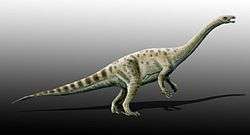Massospondylidae
| Massospondylidae Temporal range: Late Triassic - Early Jurassic, Norian–Pliensbachian | |
|---|---|
 | |
| An example of Massospondylidae, Adeopapposaurus | |
| Scientific classification | |
| Kingdom: | Animalia |
| Phylum: | Chordata |
| Class: | Reptilia |
| Clade: | Dinosauria |
| Order: | Saurischia |
| Suborder: | †Sauropodomorpha |
| Clade: | †Massopoda |
| Family: | †Massospondylidae Huene, 1914 |
| Type species | |
| †Massospondylus carinatus Owen, 1854 | |
| Genera[1] | |
Massospondylidae is a family of early massopod dinosaurs[3][4] that existed in Asia, Africa and South America during the Late Triassic to the Early Jurassic periods. Several dinosaurs have been classified as massospondylids over the years. The largest cladistic analysis of early sauropodomorphs, which was presented by Apaldetti and colleagues in November 2011, found Adeopapposaurus, Coloradisaurus, Glacialisaurus, Massospondylus, Leyesaurus and Lufengosaurus to be massospondylids.[5] This result supports many previous analyses that tested fewer taxa.[4][6][7][8] However, this analysis found the two recently described North American massopods, Sarahsaurus and Seitaad, and the South African Ignavusaurus to nest outside Massospondylidae, as opposed to some provisional proposals.[9][10] Earlier in 2011, Pradhania, a sauropodomorph from India, was tested for the first time in a large cladistic analysis and was found to be a relatively basal massospondylid.[2] Mussaurus and Xixiposaurus may also be included within Massospondylidae.[11]
Phylogeny
Massospondylidae, which was first named by Huene in 1914, is a stem-based taxon. It was defined by Sereno as all animals more closely related to Massospondylus carinatus than to Plateosaurus engelhardti and Saltasaurus loricatus.[12]
The following simplified cladogram is based on an analysis presented by Apaldetti and colleagues in 2011.[5]
| Massopoda |
| |||||||||||||||||||||||||||||||||||||||||||||||||||||||||||||||||||||||||||||||||||||||
| |
The following simplified cladogram is based on an analysis presented by Novas et al., 2011:[2]
| Massopoda |
| |||||||||||||||||||||||||||||||||||||||||||||||||||||||||
| |

References
- ↑ McPhee, B. W.; Yates, A. M.; Choiniere, J. N.; Abdala, F. (2014). "The complete anatomy and phylogenetic relationships of Antetonitrus ingenipes(Sauropodiformes, Dinosauria): Implications for the origins of Sauropoda". Zoological Journal of the Linnean Society. 171: 151. doi:10.1111/zoj.12127.
- 1 2 3 Fernando E. Novas, Martin D. Ezcurra, Sankar Chatterjee and T. S. Kutty (2011). "New dinosaur species from the Upper Triassic Upper Maleri and Lower Dharmaram formations of central India". Earth and Environmental Science Transactions of the Royal Society of Edinburgh. 101 (3–4): 333–349. doi:10.1017/S1755691011020093.
- ↑ Yates, Adam M. (2003). "Species taxonomy of the sauropodomorph dinosaurs from the Löwenstein Formation (Norian, Late Triassic) of Germany". Palaeontology. 46 (2): 317–337. doi:10.1111/j.0031-0239.2003.00301.x.
- 1 2 Yates, Adam M. (2007). "The first complete skull of the Triassic dinosaur Melanorosaurus Haughton (Sauropodomorpha: Anchisauria)". In Barrett & Batten (eds.), Evolution and Palaeobiology: 9–55.
- 1 2 Cecilia Apaldetti, Ricardo N. Martinez, Oscar A. Alcober and Diego Pol (2011). Claessens, Leon, ed. "A New Basal Sauropodomorph (Dinosauria: Saurischia) from Quebrada del Barro Formation (Marayes-El Carrizal Basin), Northwestern Argentina". PLoS ONE. 6 (11): e26964. Bibcode:2011PLoSO...626964A. doi:10.1371/journal.pone.0026964. PMC 3212523
 . PMID 22096511.
. PMID 22096511. - ↑ Smith, Nathan D.; Pol, Diego (2007). "Anatomy of a basal sauropodomorph dinosaur from the Early Jurassic Hanson Formation of Antarctica" (pdf). Acta Palaeontologica Polonica. 52 (4): 657–674.
- ↑ Martínez, Ricardo N. (2009). "Adeopapposaurus mognai, gen. et sp. nov (Dinosauria: Sauropodomorpha), with comments on adaptations of basal sauropodomorpha". Journal of Vertebrate Paleontology. 29 (1): 142–164. doi:10.1671/039.029.0102.
- ↑ Diego Pol, Alberto Garrido, Ignacio A. Cerda (2011). Farke, Andrew Allen, ed. "A New Sauropodomorph Dinosaur from the Early Jurassic of Patagonia and the Origin and Evolution of the Sauropod-type Sacrum". PLoS ONE. 6 (1): e14572. Bibcode:2011PLoSO...614572P. doi:10.1371/journal.pone.0014572. PMC 3027623
 . PMID 21298087.
. PMID 21298087. - ↑ Joseph J. W. Sertich and Mark A. Loewen (2010). Laudet, Vincent, ed. "A New Basal Sauropodomorph Dinosaur from the Lower Jurassic Navajo Sandstone of Southern Utah". PLoS ONE. 5 (3): e9789. Bibcode:2010PLoSO...5.9789S. doi:10.1371/journal.pone.0009789. PMC 2844413
 . PMID 20352090.
. PMID 20352090. - ↑ Yates, Adam M.; Matthew F. Bonnan; Johann Neveling (2011). "A new basal sauropodomorph dinosaur from the Early Jurassic of South Africa". Journal of Vertebrate Paleontology. 31 (3): 610–625. doi:10.1080/02724634.2011.560626.
- ↑ SEKIYA Toru (2010). "A new prosauropod dinosaur from Lower Jurassic in Lufeng of Yunnan". Global Geology. 29 (1): 6–15. doi:10.3969/j.issn.1004-5589.2010.01.002.
- ↑ Sereno, P.C. (1998). "A rationale for phylogenetic definitions, with applications to the higher-level taxonomy of Dinosauria". Neues Jahrbuch fur Geologie und Palaontologie: Abhandlungen. 210: 41–83.